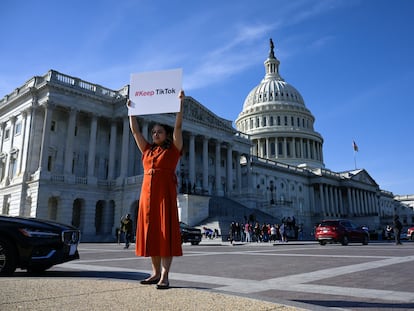Does ‘liking’ everything mean you’re old?
Celebrities like Iker Casillas have become meme fodder over supposed overuse of a 15-year-old internet feature


There was a moment in which the like first became the atom of social approval — and it wasn’t all that long ago. The like didn’t appear as a feature on the first massive social network, Facebook, until 2009. On YouTube, it showed up in 2010. Instagram, which was born that year, had us liking things from day one, becoming the app that elevated the practice to the highest ranks of social more. Such was the like’s popularity at this point that it began to make the news. In 2019, EL PAÍS ran a headline which, in English, translates to “Selena Gomez has the photo with the most likes ever in the history of Instagram.” Those historic four million little hearts were tapped on an image of the star drinking a soft drink through a straw. Today, that figure is nothing. The current recordholder is Lionel Messi, whose photo holding Argentina’s World Cup trophy in 2022 garnered nearly 75 million likes. Though these mini-statements of approval are free to those who give them out, in the era of late capitalism and self-exploitation, they can amount to a deposit on a new apartment for those on the receiving end, if enough are amassed.
This week, the like was in the news again for a rather trifling cause: it seems, according to internet denizens, that Spanish soccer player Iker Casillas is liking too many things. He’s given a heart to left-wing member of the European Parliament Irene Montero and the neoliberal regional premier of Madrid, Isabel Díaz Ayuso, alike. Analysts of such things have noted that, in liking the photos of so many women, Casillas is ironically protecting his privacy and throwing off celebrity news sleuths that track such interactions. All the same, the memes have been ruthless, suggesting that Casillas not only has bad taste when it comes to current affairs, but also, that there is a certain generation gap when it comes to the like. Young people think that adults use it too freely. We have spoken to individuals of different age groups in our immediate newsroom environs to get to the heart of the matter.
At first, the like was a sign of laziness. The feature was a way to express approval of the content another user had uploaded without having to actually comment on it. A like showed that you’d seen a friend’s photo and that it was pleasing to you, but perhaps not compelling enough to take the time to write “nice landscape!” The option gave rise to like monitors, those who keep tally of who does and doesn’t dole out the digital hearts. As in so many other areas, likes generated their own language and hidden currents of meaning: in 2019, Instagram announced that it was debuting the option of hiding the number of likes received, in an attempt to put an end to the excessive drive for online popularity and like anxiety among younger users (in 2025 amid his new era as a Trumper, Mark Zuckerberg has decidedly stopped caring about such youthful angst.)
Paradoxically, not too long afterwards in 2022, likes arrived in the private sphere: a person could heart a story, that ephemeral Instagram content that disappears after 24 hours. But by then, the like had all but conquered the public domain, even in the IRL world. Witness the little satisfaction buttons we use to rate the person who rings up our purchase at the mall, a waiter’s demure request that you give them a good rating on a hospitality review apps (“my boss will see it”) and the algorithms that decide your skill as a worker depending on how quickly you have relayed a pizza from a restaurant to someone’s apartment on a rainy day. The little heart symbol has brought us into a world ruled by tiny onscreen organs.
But I like everyone!
In any dictatorship, even those that are heart-shaped, citizens tend to develop internal policing systems, and so too do the users of Instagram (or other social networks in which the like dominates expressions of content approval) and now display a kind of intuition as to whether a like will or should be forthcoming. A selfie, a scantily clad thirst trap, family portraits or any shot that features a baby are sure bets when it comes to doubling one’s number of likes. Too much text on a photo that doesn’t show any people? Digital agony. We’ve also learned to group our contacts by typology, according to their generosity in leaving us little red tokens of their affection. And of course, everyone knows their own personal policy when it comes to handing them out.
Although it sometimes seems like Instagram has become the domain of thirty-somethings as compared to the meteoric TikTok powered by dancing teenagers, users between the ages of 18 and 24 (the ‘Gram’s minimum age requirement is 13) continue to be the network’s majority, amounting to 31.7% of its total accounts in 2024 and slightly outnumbering its 25-to-34-year-old contingent, which clocks in at 30.6%, according to Statista. Twenty-four year old journalist Lucas Barquero agrees with the popular theory that the like is a gesture more typical of the mature social media user. “I give very few likes to reels and posts. Before, there was a general obsession, you’d go crazy giving likes to everything so that people would give them back to you. Now, I reserve them for what I find truly interesting.”
Barquero’s words put a fine point on the difference age can make when it come to the like. “Many times, I have gotten a like on an old photo and thought someone was trying to flirt and then realized that it was my great-aunt communicating that she had discovered a publication from years ago that she enjoys. In general, I think that the most common way to flirt these days is to like a story. It’s so ambiguous that it can mean almost anything, and I think that’s what makes it perfect. The activist like, on the other hand, is more something that you have to be looking for than something you run across by chance. You find it when you go to the account of a political party or organization and take a look at who has liked their latest post. It can be a tool in a sociological study you want to carry out, including those on certain actors or singers.”
In fact, the like can sometimes arouse suspicion: not just when a public figure likes a particular piece of content pertaining to a particular ideology, serving to categorize them within said school of thought, but also among groups of friends for whom a like for the wrong person can get someone in trouble. If (let’s say) Pedro makes a post and (let’s say) Luis expresses his disagreement, a like for Luis signals a declaration of war against Pedro. And such sentiments will not stay on the internet — tread carefully the next time those involved find themselves in the same bar.
Barquero points out that a like can carry with it no small amount of passive-aggression. “The like in response to a direct message may appear inoffensive, but can be devastating in its ability to shut down an entire conversation.” Meaning, the act of merely affixing a heart to what someone says is an indication that you like what they had to offer — but not enough to keep talking to them. It’s the online equivalent of a half-smile offered before turning to talk to another guest at a party. “The ambiguity it unleashes is intolerable, especially in the context of romantic courtship,” continues Barquero. “But it’s important not to confuse a like on a direct message with a like in response to a comment on a post. The latter is much less common and as such, much more comforting. It is reserved for the most ingenious comments and attracts attention. The user who made the original post can reward favored commenters with this kind of like. Translation? I saw you left me a comment and I’m demonstrating my appreciation by putting this tiny heart on it.”
Less hearts, more words
Enrique Rey is 32, a sailing instructor and also a contributor and columnist at EL PAÍS. For him, the meaning of the like is inextricable from the platform on which it is given. For example, the most valuable like is given on Facebook. “I made intensive use of that platform years ago and I see it as a recognition of wit. It carries a certain intellectual weight and often rewards discourse. The like given on X, in contrast, doesn’t interest me at all and almost seems like an affront compared to the retweet. And the like on Instagram, which is above all an image platform, I suppose, is the like that is most charged with direct erotic intention.”
“I’m very generous with likes,” he continues. “I give them most often to people who I enjoy on their most everyday posts. I don’t focus as much on the post as the fact that this person is braving the routine and the misery of life and is alive for another day. For example, someone posted a plate of pasta? Well, I’ll give it a like even if I don’t like the dish. It’s my way of saying, man, you had the strength to cook, you’re a machine. And if someone uploads a photo of themselves going to work, my like will say to them: you were able to get out of bed. And that’s a lot.”
All this begs the question: what do users like Rey, those who are generous with their use of the heart on social media, do when they like-like something for real? “The like in and of itself has been denatured, so when you truly like a post and think it’s fun or smart, I think you should pair it with a comment that makes it clear that you like it.”
The altruism of a like
Raquel Peláez is 46 years old and is the author of the essay Quiero y no puedo. Una historia de los pijos en España (I want to and I can’t. A history of snobs in Spain; Blackie Books) and deputy director of S Moda, the EL PAÍS fashion vertical. She gives a like “to anyone who uploads a selfie who doesn’t rub me the wrong way. I consider it an altruistic action. Also, to jokes that make me laugh, furniture, paintings, beautiful self-help memes or drawings and philosophy to train my algorithm, and to people who say things that I think are brilliant, so that they know that I agree.” Regarding the like associated with flirtation, she says she doesn’t give out many. “I’ve done it sometimes with my situationships, so that they don’t forget I’m out there. But never in the way that guys do who bury you in likes in such a demented and obvious way, which kind of offends me.”
Peláez presents a contrasting viewpoint, saying that stingy likers, the silent voyeurs, become almost more present than the smooth talkers through pure reverse psychology. When one of their likes appears, it is cause for celebration, as when one receives a token of affection from one who rarely gives them away. “They force you to look at what you uploaded the time you got a like from them to try to figure out the secret to winning them over. I hate them, but at the same time, they’ve got my attention.”
Sign up for our weekly newsletter to get more English-language news coverage from EL PAÍS USA Edition
Tu suscripción se está usando en otro dispositivo
¿Quieres añadir otro usuario a tu suscripción?
Si continúas leyendo en este dispositivo, no se podrá leer en el otro.
FlechaTu suscripción se está usando en otro dispositivo y solo puedes acceder a EL PAÍS desde un dispositivo a la vez.
Si quieres compartir tu cuenta, cambia tu suscripción a la modalidad Premium, así podrás añadir otro usuario. Cada uno accederá con su propia cuenta de email, lo que os permitirá personalizar vuestra experiencia en EL PAÍS.
¿Tienes una suscripción de empresa? Accede aquí para contratar más cuentas.
En el caso de no saber quién está usando tu cuenta, te recomendamos cambiar tu contraseña aquí.
Si decides continuar compartiendo tu cuenta, este mensaje se mostrará en tu dispositivo y en el de la otra persona que está usando tu cuenta de forma indefinida, afectando a tu experiencia de lectura. Puedes consultar aquí los términos y condiciones de la suscripción digital.
More information
Archived In
Últimas noticias
From Andorra to Gibraltar, a black market for Ozempic exploits its success: ‘They’re the most sought-after products in the world’
From Hungary’s Orbán to Chile’s Kast: How Trump helps turbo charge the far right
Magnets in their heads: How some animals guide themselves using the Earth’s magnetic field
The brief rise and retreat of Generation Z in Mexico
Most viewed
- Why we lost the habit of sleeping in two segments and how that changed our sense of time
- Trump’s obsession with putting his name on everything is unprecedented in the United States
- Charles Dubouloz, mountaineering star, retires at 36 with a farewell tour inspired by Walter Bonatti
- The Florida Keys tourist paradise is besieged by immigration agents: ‘We’ve never seen anything like this’
- Living in a motorhome due to soaring housing prices in Madrid: ‘I got used to it quickly, but I don’t idealize it’









































